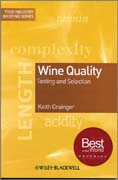
This book provides a concise, easy to use and clearly presented understandingof the techniques of wine tasting, quality assessment and evaluation. The reader is taken through the various stages of a structured and professional approach to tasting and the book examines the questions as to what constitutes quality in wines, how quality can be recognized and how it is achieved. Also discussed are the faults that can destroy wines at any quality level, and misconceptions as to quality and guarantees. INDICE: Series Editors Foreword. Preface. Acknowledgements. Introduction. CHAPTER 1 Wine Tasting. 1.1 Wine tasting suitable conditions. 1.4 Appropriate equipment. 1.5 Tasting order. 1.6 Temperature of wines for tasting. 1.7 Tasting for specific purposes. 1.8 Structured tasting technique. 1.9 The importance of keeping notes. CHAPTER 2 Appearance. 2.1 Clarity. 2.2 Intensity. 2.3 Colour. 2.4 Other observations. CHAPTER 3 Nose. 3.1 Condition. 3.2 Intensity. 3.3 Development. 3.4 Aroma characteistics. CHAPTER 4 Palate. 4.1 Sweetness/bitterness/acidity/saltiness/umami. 4.2 Dryness/sweetness. 4.3 Acidity. 4.4 Tannin. 4.5Alcohol. 4.6 Body. 4.7 Flavour intensity. 4.8 Flavour characteristics. 4.9 Other observations. 4.10 Length. CHAPTER 5 Tasting Conclusions. 5.1 Quality. 5.2Reasons for quality. 5.3 Readiness for drinking/potential for ageing. 5.4 Price/value. 5.5 Identification/true to type? 5.6 Grading wine the award of points. 5.7 Blind tasting. 5.7.1 Why taste blind? 5.7.2 Blind or sighted? 5.7.3 Tasting for quality. 5.7.4 Practicalities. 5.7.5 Examination tastings. CHAPTER 6 Wine Faults and Flaws. 6.1 Chloroanisoles and bromoanisoles. 6.2 Fermentation in the bottle Assurances and guarantees? 7.1 Compliance with Quality Wine legislation as an assurance of quality? 7.11 The European Union and Third Countries. 7.12 Table Wine and QWPSR. 7.13 The concept of Appellation Contrôlée. 7.2 Tasting competitions as an assessment of quality? 7.3 Classifications as an official assessment of quality? 7.4 ISO 9001 Certification as an assurance of quality? 7.5 Established brands as a guarantee of quality? 7.6 Price as an indication of quality? CHAPTER 8 Quality The Natural Factors and a Sense of Place. 8.1 Typcity and regionality. 8.2 The impact of climate upon quality wine production. 8.3 The role of soils. 8.4 Terroir. 8.5 The vintage factor. CHAPTER 9 Constraints upon Quality Wine Production. 9.1 Financial. 9.2 Skills and diligence. 9.3 Legal. 9.4 Environmental. CHAPTER 10 Production of Quality Wines. 10.1 Yield. 10.2 Density of Planting. 10.3 Age of vines. 10.4 Winter pruning. 10.5 Stressing the vines. 10.6 Green harvesting. 10.7 Harvesting. 10.7.1 Mechanicalharvesting. 10.7.2 Hand picking. 10.8 Delivery and processing of fruit. 10.9 Selection and sorting. 10.10 Use of pumps/gravity. 10.11 Control of fermentations. 10.12 Use of gasses. 10.13 Barrels. 10.14 Selection from vats or barrels.10.15 Storage. CHAPTER 11 Selection by Buyers. 11.1 Supermarket dominance. 11.2 Price point/margin. 11.3 Selecting for market and customer base. 11.4 Styles and individuality. 11.5 Continuity. 11.6 The place of individual wines in the range. 11.7 Exclusivity. 11.8 Specification. 11.9 Technical analysis. Glossary. Bibliography. Useful Websites. Exhibitions
- ISBN: 978-1-4051-1366-3
- Editorial: Wiley-Blackwell
- Encuadernacion: Rústica
- Páginas: 184
- Fecha Publicación: 16/01/2009
- Nº Volúmenes: 1
- Idioma: Inglés
